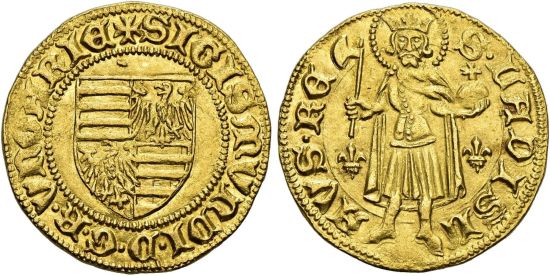Difference between revisions of "Hungary (1387-89) goldgulden Fr-9"
(revised bibliography) |
m (Text replacement - "Nagybanya mint" to "Nagybánya mint") |
||
| Line 15: | Line 15: | ||
''Link to:'' | ''Link to:'' | ||
* [[Hungary (1387-96) goldgulden Fr-9|(1387-96) goldgulden, Buda mint]] | * [[Hungary (1387-96) goldgulden Fr-9|(1387-96) goldgulden, Buda mint]] | ||
| − | * [[Hungary (1387-1401) goldgulden Fr-9]], | + | * [[Hungary (1387-1401) goldgulden Fr-9]], Nagybánya mint |
* [[Hungary (1387-1437) goldgulden Fr-9|(1387-1437) goldgulden, Offenbanya mint]] | * [[Hungary (1387-1437) goldgulden Fr-9|(1387-1437) goldgulden, Offenbanya mint]] | ||
* [[Hungary (1399)-MA goldgulden Fr-9|(1399)-MA goldgulden, Buda mint]] | * [[Hungary (1399)-MA goldgulden Fr-9|(1399)-MA goldgulden, Buda mint]] | ||
Revision as of 10:42, 13 August 2024
This specimen was lot 712 in Sincona sale 89 (Zurich, May 2024), where it sold for 2,600 CHF (about US$3,436 including buyer's fees). The catalog description[1] noted,
"UNGARN, Sigismund, 1387-1437. Goldgulden o. J. (1387-1389), Kaschau. Kammergrafen Jacobus und Christianus (?). Selten. Vorzüglich. Exemplar der Auktion Spink Taisei 39, Zürich, Oktober 1991, Los 68. (kingdom of Hungary, Sigismund, 1387-1437, undated goldgulden, Kaschau mint. Rare, Extremely fine.)"
The ducats or florins or goldgulden of Hungary are among the more common gold coins of the late middle ages. During Sigismund's reign, the goldgulden matched the ducat; later issues were lighter and lower in fineness.
Recorded mintage: unknown.
Specification: 3.49 g, 0.986 fine gold, this specimen 3.54 g.
Catalog reference: Pohl D1-6, Lengyel 17/11A, Huszar 572, Fr-9.
- Friedberg, Arthur L. and Ira S. Friedberg, Gold Coins of the World, From Ancient Times to the Present, 9th ed., Clifton, NJ: Coin and Currency Institute, 2017.
- [1]Richter, Jurg, SINCONA Auction 89, The Garrulus Collection of Numismatic Rarities and Masterpieces, Zurich: SINCONA AG, 2024.
Link to:
